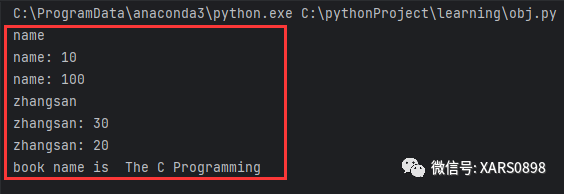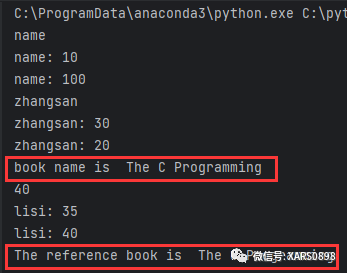

Python的面向对象编程详解
嵌入式技术
1412人已加入
描述
一般编程可分为面向过程编程,和面向对象编程。Python的面向对象编程,与Java的面向对象很像。之所以需要面向对象编程,是为了更好地实现封装、继承、多态。
为了更加清晰地介绍Python的面向对象编程,以简单的代码作为案例,在案例中阐释Python的面向对象编程。
实验环境:Linux/Windows+Python3
1、定义类对象
# 类以关键字class开头
# 类名首字母都大写
class ClassName:
# 构造函数,定义实例的属性
# 构造函数的名称固定,后面可以跟任意个数参数,但第一个参数是默认的self
def __init__(self, name, age):
self.name = name
self.age = age
# 创建实例对象,__init__将被调用
person = ClassName("name", 100)
# 获取对象的值
print(person.name)
执行该程序,将会打印

2、定义类函数
# 类以关键字class开头
# 类名首字母都大写
class ClassName:
# 构造函数,定义实例的属性
# 构造函数的名称固定,后面可以跟任意个数参数,但第一个参数是默认的self
def __init__(self, name, age):
self.name = name
self.age = age
# 与普通函数定义类似,但第一个参数默认为self
def functionName(self, age):
print(self.name + ":", age)
print(self.name + ":", self.age)
# 创建实例对象,__init__将被调用
person = ClassName("name", 100)
# 获取对象的值
print(person.name)
# 调用类函数
person.functionName(10)
执行该程序,将会打印

3、继承父类
# 子类继承父类,后面加一个圆括号,里面放父类名称
class Student(ClassName):
# 子类也需要构造方法
def __init__(self, name, age, claRoom):
# 继承父类的构造方法
super().__init__(name, age)
self.claRoom = claRoom
def read(self, book):
print("book name is ", book)
# 创建一个子类对象
student = Student("zhangsan", 20, 201)
# 获取子类的名称
print(student.name)
# 利用父类方法打印信息
student.functionName(30)
# 打印子类独有的信息
student.read("The C Programming")
执行该程序,将会打印

4、多态
class Teacher(ClassName):
# 子类也需要构造方法
def __init__(self, name, age, claRoom):
# 继承父类的构造方法
super().__init__(name, age)
self.claRoom = claRoom
# 定义的方法名称与Student相同,但是功能不同
def read(self, book):
print("The reference book is ", book)
teacher = Teacher("lisi", 40, "T301")
print(teacher.age)
teacher.functionName(35)
teacher.read("The C Programming")
程序打印

虽然都调用了read方法,但是两者实例对象不同,所执行的功能不同,这就是多态的妙处。
案例代码没有给出非常详细的解释,刨除了很多语法细节,可以作为一个快速掌握Python面向对象编程的笔记查阅。
声明:本文内容及配图由入驻作者撰写或者入驻合作网站授权转载。文章观点仅代表作者本人,不代表电子发烧友网立场。文章及其配图仅供工程师学习之用,如有内容侵权或者其他违规问题,请联系本站处理。
举报投诉
-
什么是面向对象编程(OOP)?面向对象的程序设计2023-07-19 1943
-
Python中的类和对象详解2023-04-20 1705
-
西门子PLC面向对象编程2023-04-17 801
-
面向对象编程介绍2021-12-13 2169
-
面向对象编程语言的特点2021-09-08 1373
-
基于面向对象的LabVIEW编程有哪些优势2021-08-24 2078
-
面向对象编程及其三大特性 精选资料分享2021-07-21 1261
-
这可能是Python面向对象编程的最佳实践2019-06-22 3091
-
史上最全Python面向对象编程的资料合集2019-03-30 3961
-
plc面向对象编程架构与实现2019-01-31 4688
-
3分钟看懂Python面向对象2018-06-08 2245
-
labview面向对象编程2011-11-24 123052
-
面向对象编程练习2008-09-23 3284
全部0条评论

快来发表一下你的评论吧 !

